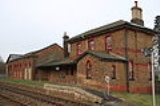
Bealings railway station
Encyclopedia
Bealings railway station was a station in Little Bealings
, Suffolk
on the line between Ipswich
and Lowestoft
. While the line remains open to this day, the station was shut on 17 September 1956 and both the station building and platforms still survive today.
It was opened by the Eastern Union Railway
on 1st June 1859 when the full East Suffolk Line
opened between Great yarmouth in Norfolk and Ipswich in Suffolk. In 1862 the Eastern Union Railway was taken over by the Great Eastern Railway
who operated the station until 1923 when grouping saw the Great Eastern Railway was taken over by the London and North Eastern Railway
. The July 1922 Bradshaw's Guide showed seven up services (towards Ipswich) and seven down services calling at the station with two services each way on Sundays. Most services were local trains which would originate or terminate at Ipswich and call at most stations on the East Suffolk Line. However the station did enjoy a main line service direct to Liverpool Street. Bradshaw's stated that the 08:17 departure conveyed first and third class Pullman
carriages (there was no second class at this time)arriving in Liverpool Street
at 10:30. The return working was at 15:18 arriving back in Bealings at 17:22.
After World War 2 the railways were nationalised and Bealings station became part of British Railway's Eastern Region. Lack of patronage saw the station close in 1956.
The station building is still extant today and occupied by the Mallard Business Centre. There is a level crossing
at the east end of the station where 'the Street' crosses the line.
Former Services
Little Bealings
Little Bealings is a village in Suffolk, England. It has a population of approximately 470 people living in around 185 households. Its nearest towns are Ipswich and Woodbridge...
, Suffolk
Suffolk
Suffolk is a non-metropolitan county of historic origin in East Anglia, England. It has borders with Norfolk to the north, Cambridgeshire to the west and Essex to the south. The North Sea lies to the east...
on the line between Ipswich
Ipswich
Ipswich is a large town and a non-metropolitan district. It is the county town of Suffolk, England. Ipswich is located on the estuary of the River Orwell...
and Lowestoft
Lowestoft
Lowestoft is a town in the English county of Suffolk. The town is on the North Sea coast and is the most easterly point of the United Kingdom. It is north-east of London, north-east of Ipswich and south-east of Norwich...
. While the line remains open to this day, the station was shut on 17 September 1956 and both the station building and platforms still survive today.
It was opened by the Eastern Union Railway
Eastern Union Railway
The Eastern Union Railway was an early English railway, initially sanctioned by Act of Parliament on 19 July 1844, with authorised capital of £200,000 to build from Ipswich to Colchester. Further Acts of 21 July 1845 and 26 June 1846 authorised further increases in capital of £50,000 and £20,000...
on 1st June 1859 when the full East Suffolk Line
East Suffolk Line
The East Suffolk Line is an un-electrified secondary railway line running between Ipswich and Lowestoft in Suffolk, England. The traffic along the route consists of passenger services operated by National Express East Anglia, while nuclear flask trains for the Sizewell nuclear power stations are...
opened between Great yarmouth in Norfolk and Ipswich in Suffolk. In 1862 the Eastern Union Railway was taken over by the Great Eastern Railway
Great Eastern Railway
The Great Eastern Railway was a pre-grouping British railway company, whose main line linked London Liverpool Street to Norwich and which had other lines through East Anglia...
who operated the station until 1923 when grouping saw the Great Eastern Railway was taken over by the London and North Eastern Railway
London and North Eastern Railway
The London and North Eastern Railway was the second-largest of the "Big Four" railway companies created by the Railways Act 1921 in Britain...
. The July 1922 Bradshaw's Guide showed seven up services (towards Ipswich) and seven down services calling at the station with two services each way on Sundays. Most services were local trains which would originate or terminate at Ipswich and call at most stations on the East Suffolk Line. However the station did enjoy a main line service direct to Liverpool Street. Bradshaw's stated that the 08:17 departure conveyed first and third class Pullman
Pullman (car or coach)
In the United States, Pullman was used to refer to railroad sleeping cars which were built and operated on most U.S. railroads by the Pullman Company from 1867 to December 31, 1968....
carriages (there was no second class at this time)arriving in Liverpool Street
Liverpool Street
Liverpool Street can refer to:*Liverpool Street station, a major mainline railway station in Central London, England*Liverpool Street, Hobart, a major street in the Hobart city centre....
at 10:30. The return working was at 15:18 arriving back in Bealings at 17:22.
After World War 2 the railways were nationalised and Bealings station became part of British Railway's Eastern Region. Lack of patronage saw the station close in 1956.
The station building is still extant today and occupied by the Mallard Business Centre. There is a level crossing
Level crossing
A level crossing occurs where a railway line is intersected by a road or path onone level, without recourse to a bridge or tunnel. It is a type of at-grade intersection. The term also applies when a light rail line with separate right-of-way or reserved track crosses a road in the same fashion...
at the east end of the station where 'the Street' crosses the line.

